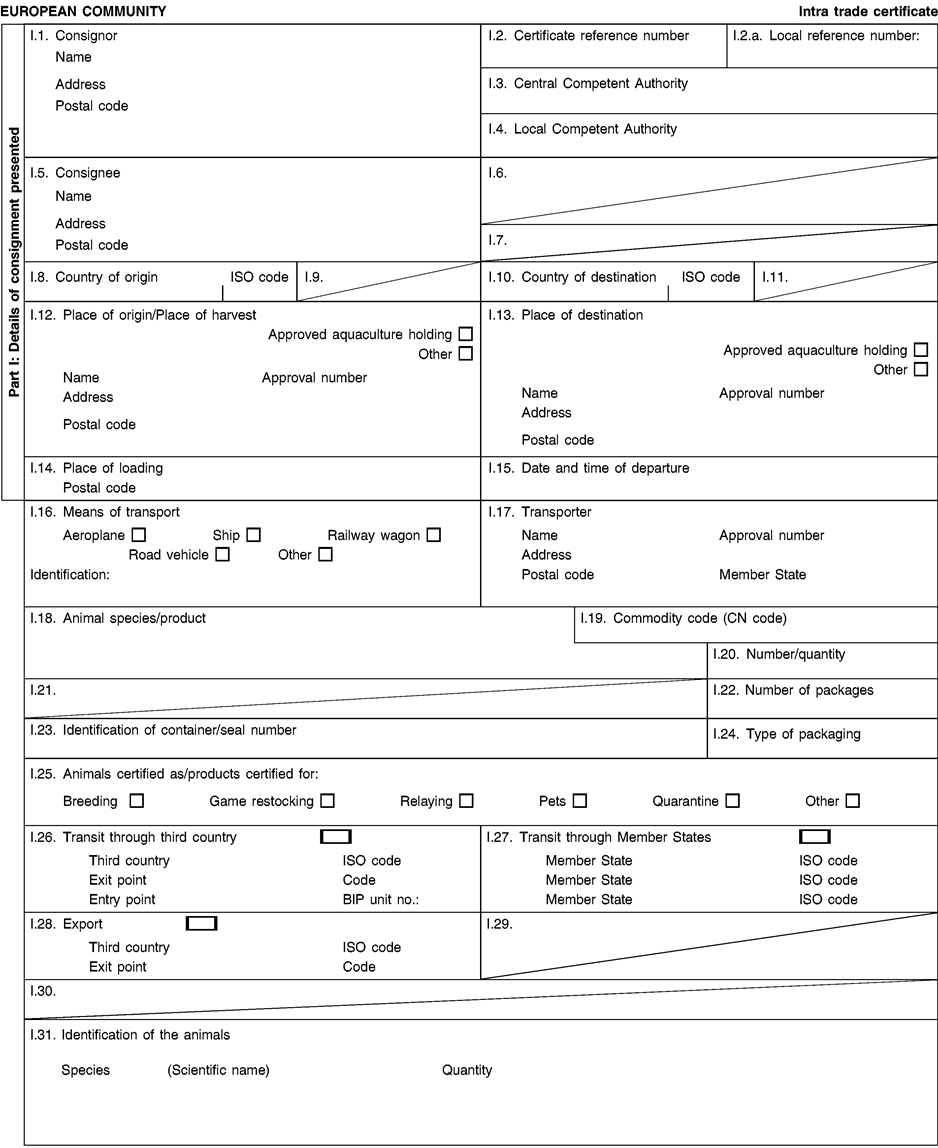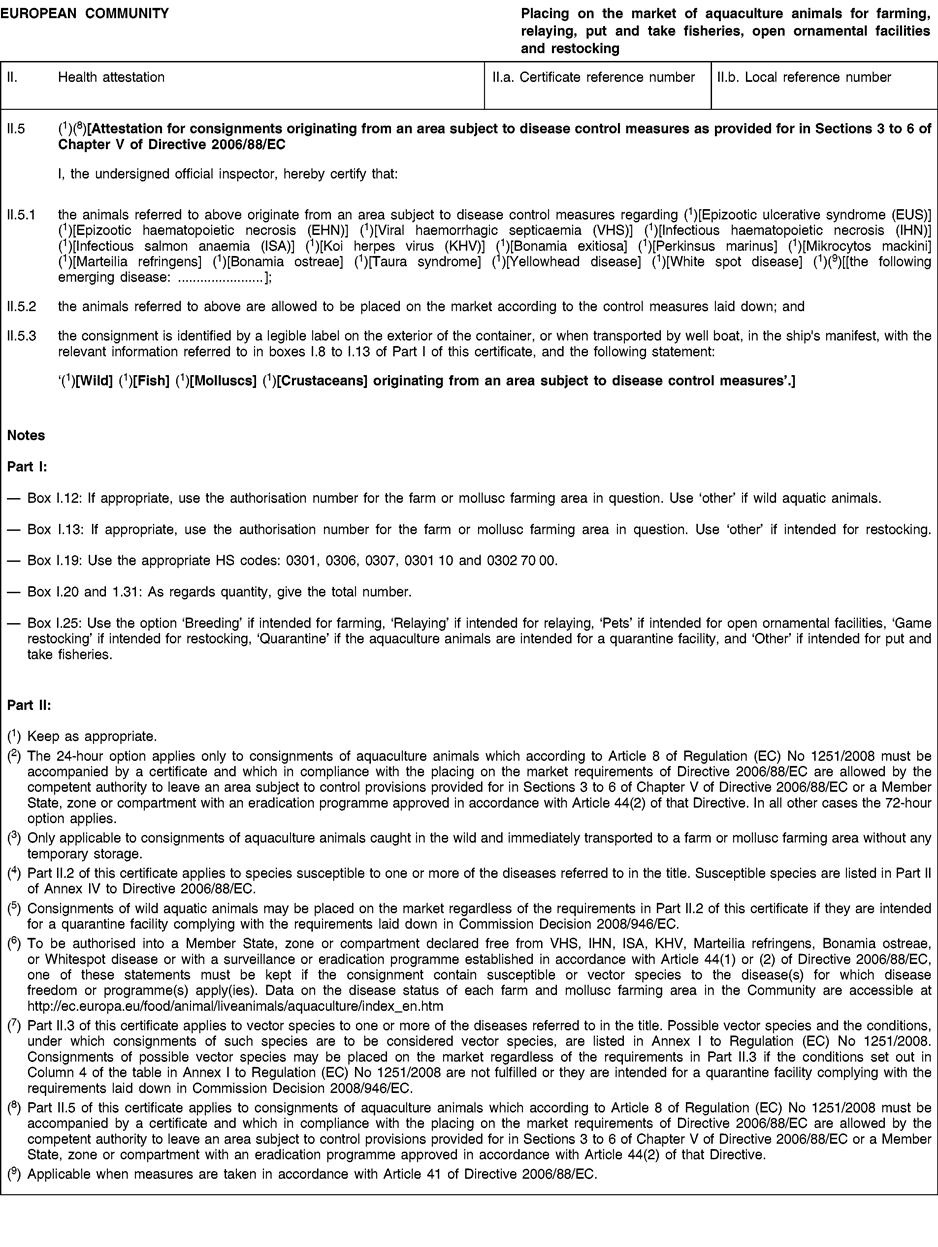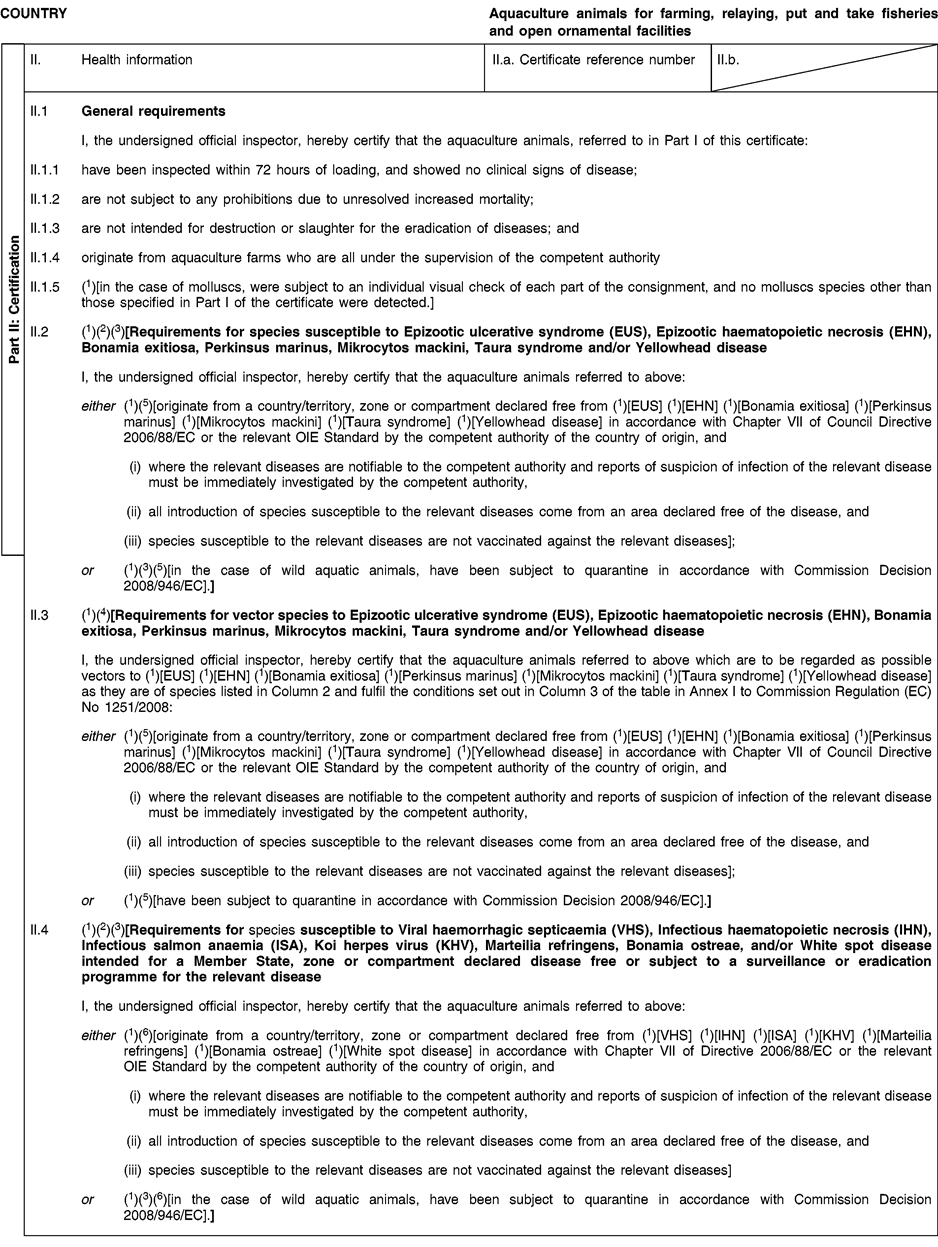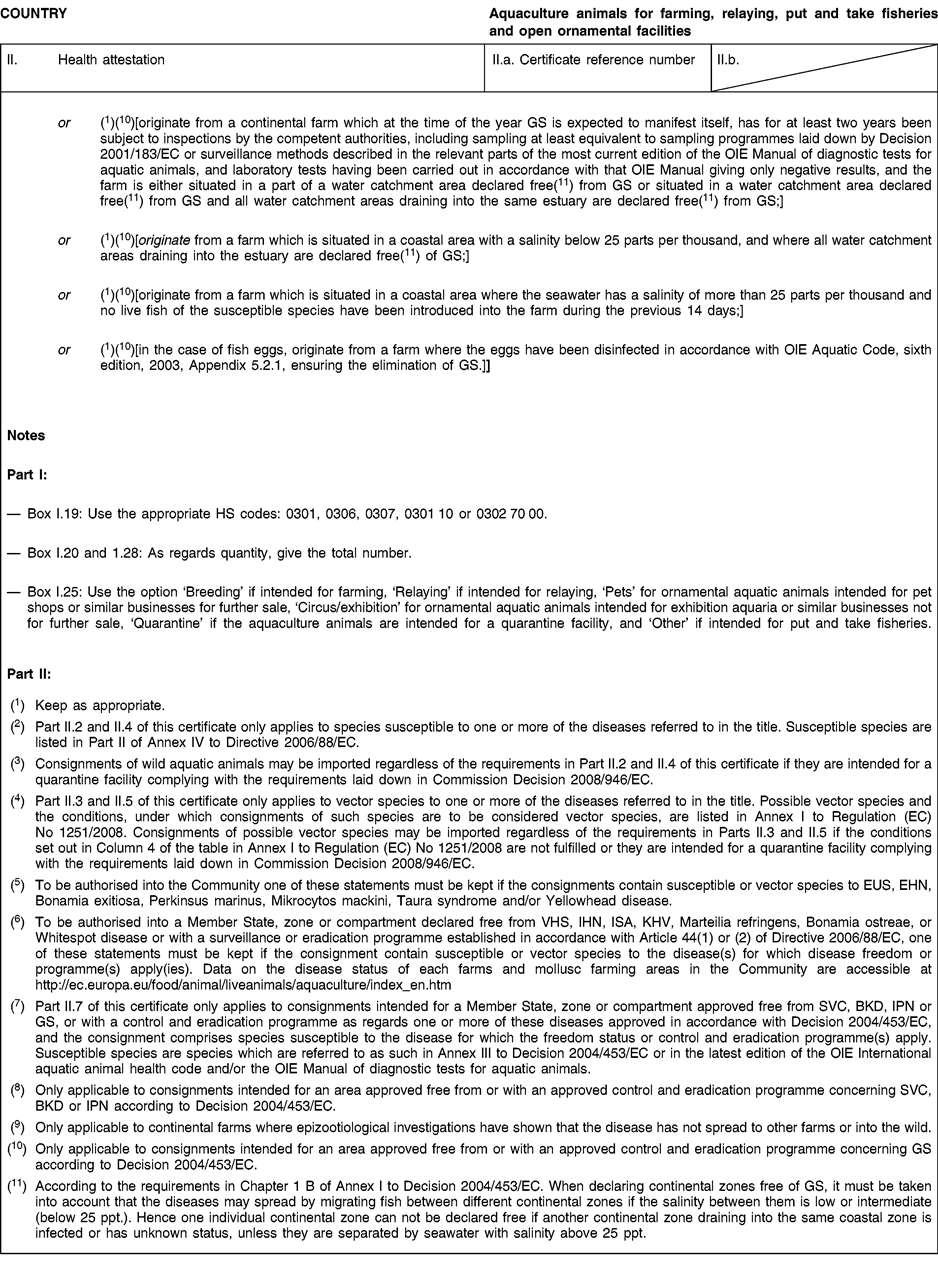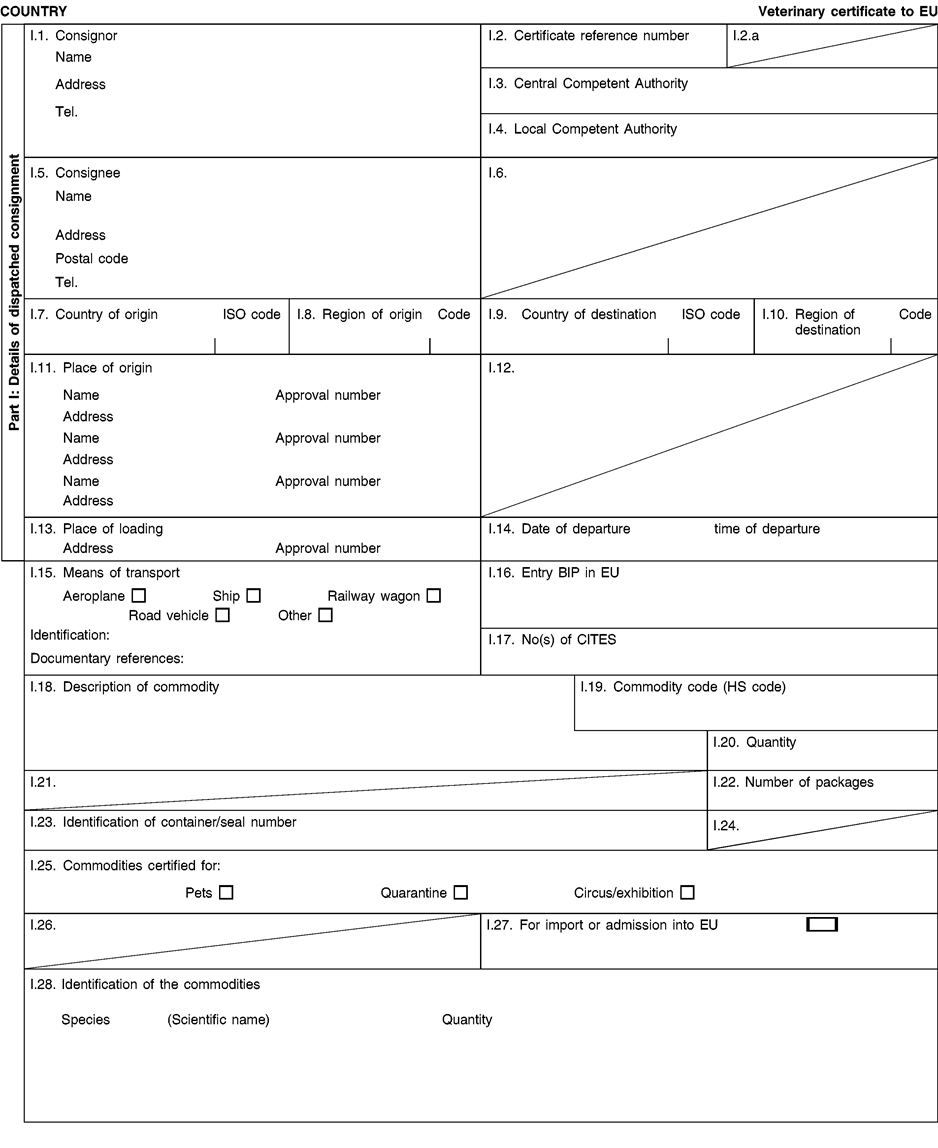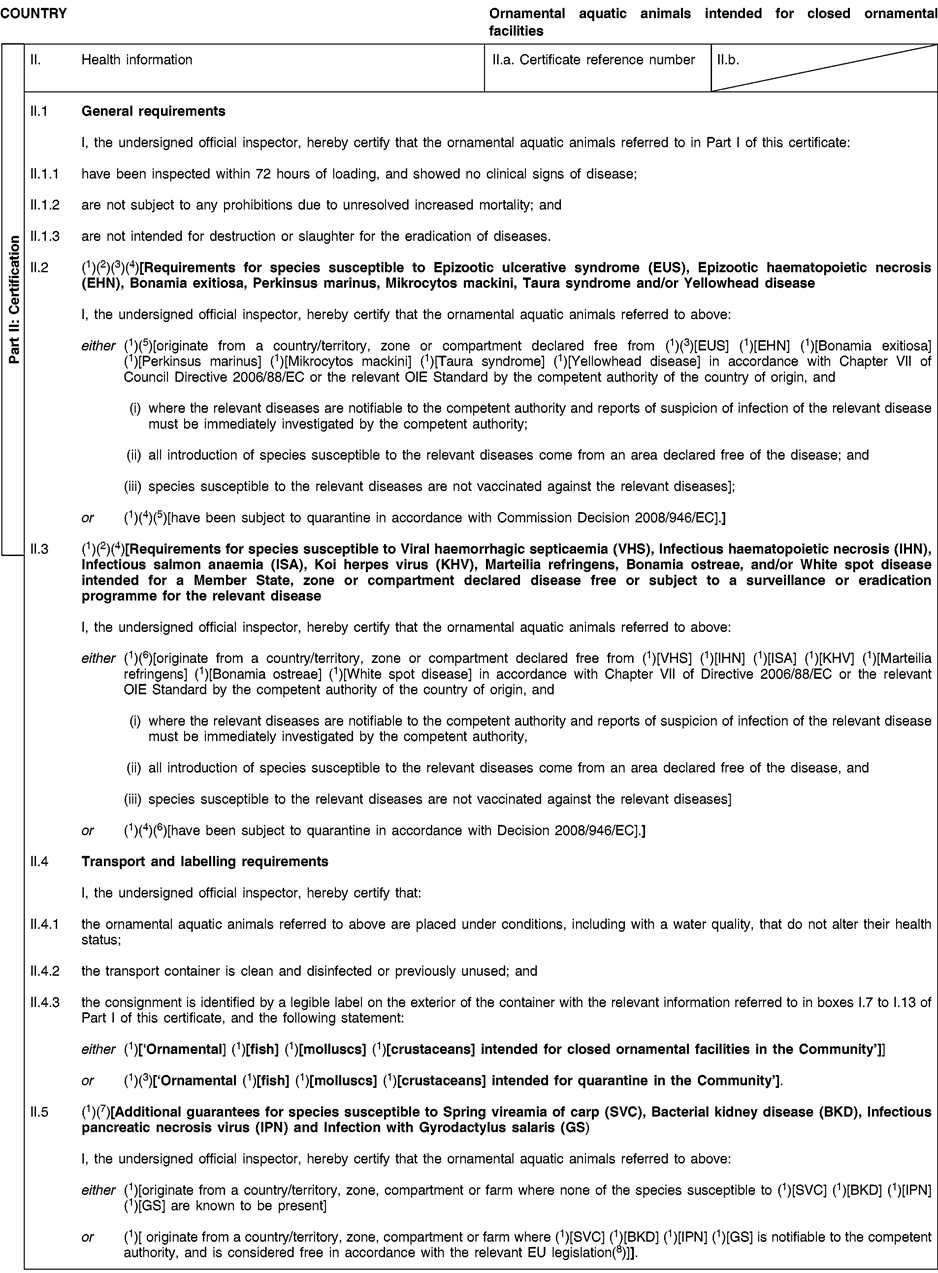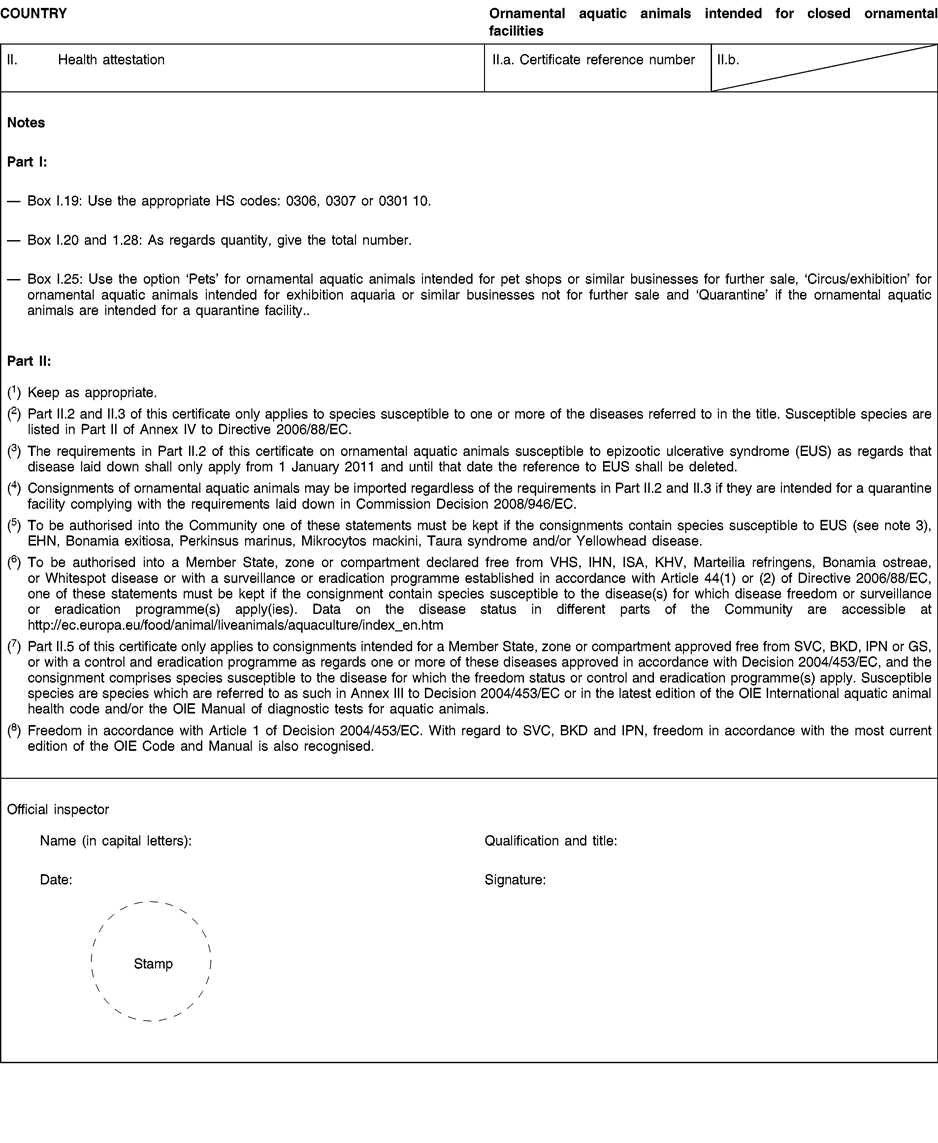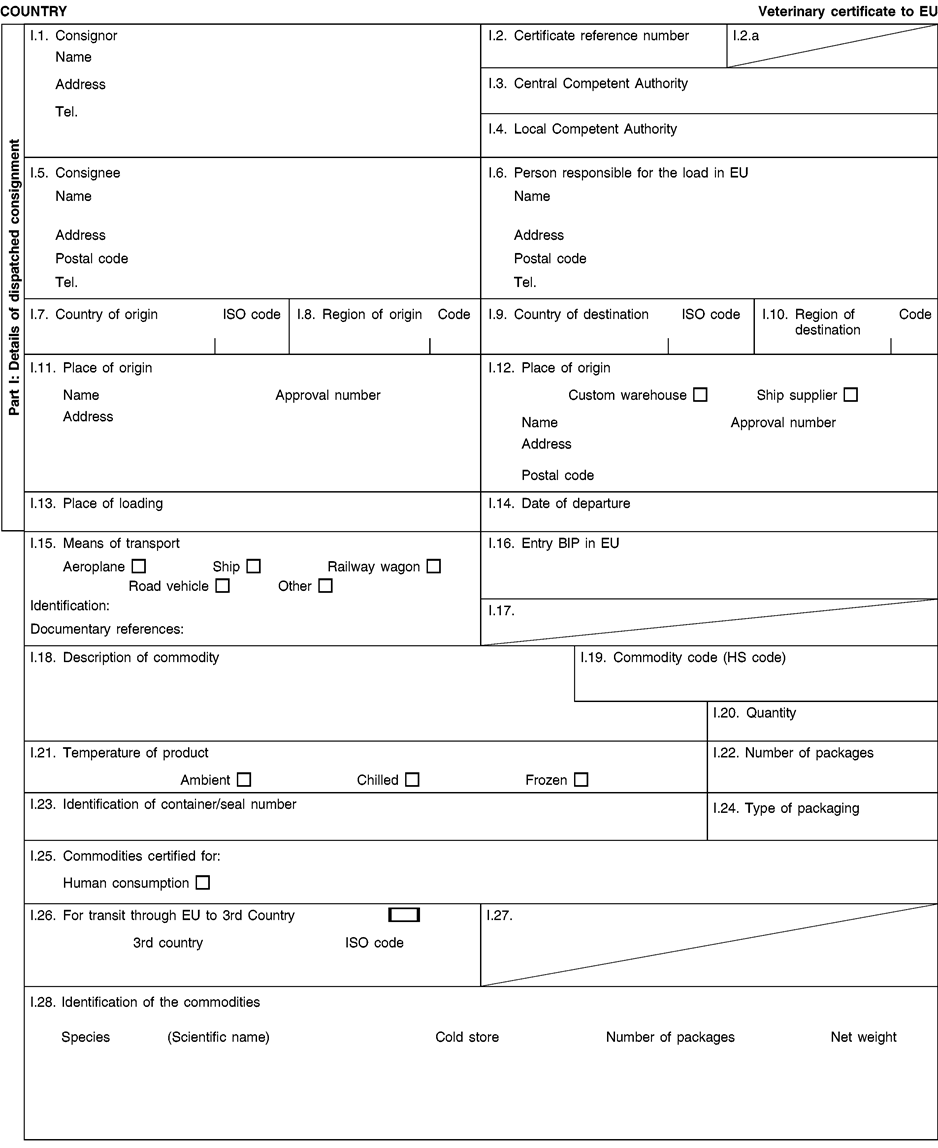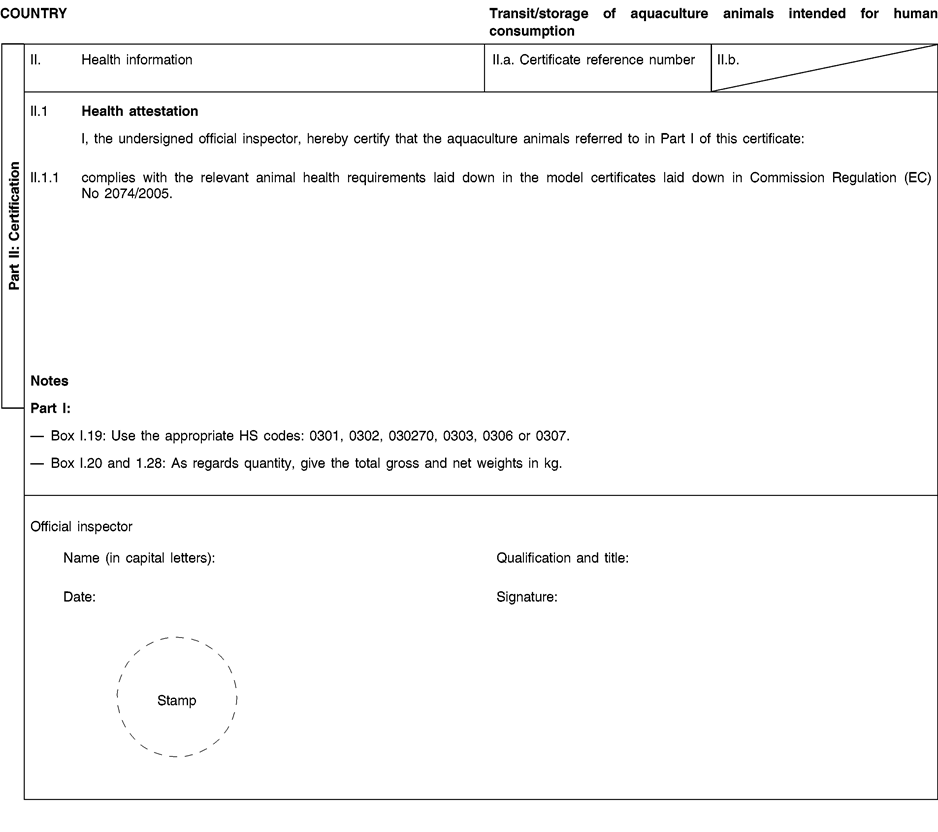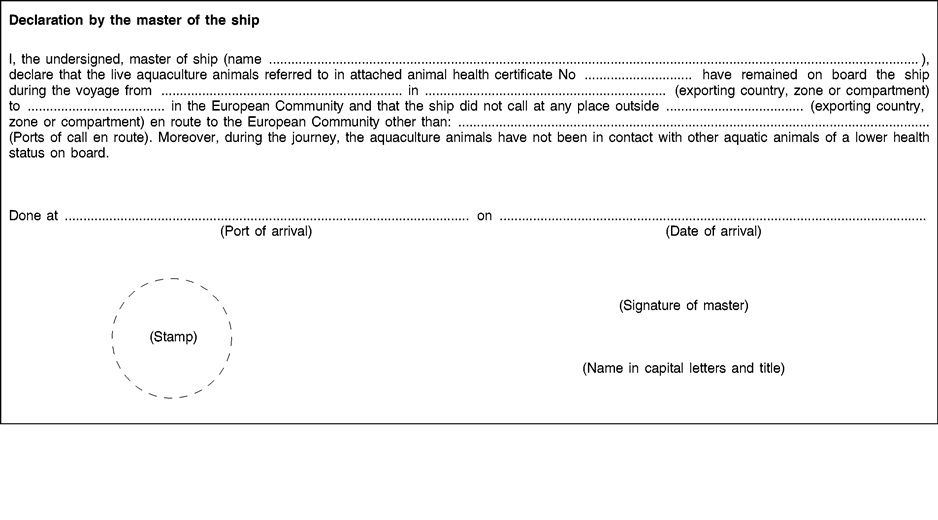- Latest available (Revised)
- Original (As adopted by EU)
Commission Regulation (EC) No 1251/2008Show full title
Commission Regulation (EC) No 1251/2008 of 12 December 2008 implementing Council Directive 2006/88/EC as regards conditions and certification requirements for the placing on the market and the import into the Community of aquaculture animals and products thereof and laying down a list of vector species (Text with EEA relevance)
You are here:
- Regulations originating from the EU
- 2008 No. 1251
- Annexes only
More Resources
Revised version PDFs
- Revised 14/12/20191.51 MB
- Revised 01/10/20161.41 MB
- Revised 03/02/20141.34 MB
- Revised 01/07/20131.34 MB
- Revised 26/11/20121.34 MB
- Revised 01/05/20111.80 MB
- Revised 01/01/20111.66 MB
- Revised 15/05/20100.71 MB
- Revised 01/10/20091.04 MB
This is a legislation item that originated from the EU
After exit day there will be three versions of this legislation to consult for different purposes. The legislation.gov.uk version is the version that applies in the UK. The EU Version currently on EUR-lex is the version that currently applies in the EU i.e you may need this if you operate a business in the EU.
The web archive version is the official version of this legislation item as it stood on exit day before being published to legislation.gov.uk and any subsequent UK changes and effects applied. The web archive also captured associated case law and other language formats from EUR-Lex.
Status:
This is the original version (as it was originally adopted).
ANNEX I
List of possible vector species and the conditions under which those species shall be regarded as vectors
| Diseases | Vectors | ||
|---|---|---|---|
| Species which shall be regarded as vectors for the purposes of Article 17(1) and (2) where the additional conditions set out in Columns 3 and 4 of this table are fulfilled | Additional conditions related to the place of origin of the aquatic animals of the species listed in Column 2 | Additional conditions related to the place of destination of the aquatic animals of the species listed in Column 2 | |
| Column 1 | Column 2 | Column 3 | Column 4 |
| Epizootic haematopoietic necrosis | Bighead carp (Aristichthys nobilis), goldfish (Carassius auratus), crucian carp (C. carassius), common carp and koi carp (Cyprinus carpio), silver carp (Hypophtalmichthys molitrix), Chub (Leuciscus spp), Roach (Rutilus rutilus), Rudd (Scardinius erythrophthalmus), tench (Tinca tinca) | No additional conditions | No additional conditions |
| Epizootic ulcerative syndrome | Bighead carp (Aristichthys nobilis), goldfish (Carassius auratus), crucian carp (C. carassius), common carp and koi carp (Cyprinus carpio), silver carp (Hypophtalmichthys molitrix), Chub (Leuciscus spp), Roach (Rutilus rutilus), Rudd (Scardinius erythrophthalmus), tench (Tinca tinca) Swan mussel (Anodonta cygnea), Noble crayfish (Astacus astacus), Signal crayfish (Pacifastacus leniusculus), Redswamp crayfish (Procambarus clarkii) | No additional conditions | No additional conditions |
| Infection with Bonamia exitiosa | Portuguese oyster (Crassostrea angulata), Pacific cupped oyster (Crassostrea gigas), American cupped oyster (Crassostrea virginica) | Aquatic animals of the species listed in Column 2 shall only be regarded as vectors for the disease listed in Column 1 where they originate from a farm or mollusc farming area where species susceptible to that disease are present. | Aquatic animals of the species listed in Column 2 shall only be regarded as vectors for the disease listed in Column 1 where they are intended for a farm or mollusc farming area keeping species susceptible to that disease. |
| Infection with Perkinsus marinus | European lobster (Homarus gammarus), Marine crabs (Brachyura spp.), Yabi crayfish (Cherax destructor), Giant river prawn (Macrobrachium rosenbergii), Spiny lobsters (Palinurus spp.), Swimming crab (Portunus puber), Indopacific swamp crab (Scylla serrata), Indian white prawn (Penaeus indicus), Kuruma prawn (Penaeus japonicus), Caramote prawn (Penaeus kerathurus), Blue shrimp (Penaeus stylirostris), Whiteleg shrimp (Penaeus vannamei) | Aquatic animals of the species listed in Column 2 shall only be regarded as vectors for the disease listed in Column 1 where they originate from a farm or mollusc farming area where species susceptible to that disease are present. | Aquatic animals of the species listed in Column 2 shall only be regarded as vectors for the disease listed in Column 1 where they are intended for a farm or mollusc farming area keeping species susceptible to that disease. |
| Infection with Microcytos mackini | None | Not applicable | Not applicable |
| Taura syndrome | Penshells (Atrina spp.), Common whelk (Buccinum undatum), Portuguese oyster (Crassostrea angulata), Common edible cockle (Cerastoderma edule), Pacific cupped oyster (Crassostrea gigas), American cupped oyster (Crassostrea virginica), Wedge shell (Donax trunculus), Ezo abalone (Haliotis discus hannai), Tuberculate abalone (Haliotis tuberculata), Periwinkles (Littorina littorea), Northern quahog (Mercenaria mercenaria), Japanese hard clam (Meretrix lusoria), Sand gaper (Mya arenaria), Blue mussel (Mytilus edulis), Mediterranean mussel (Mytilus galloprovincialis), Octopus (Octopus vulgaris), European flat oyster (Ostrea edulis), Great Atlantic scallop (Pecten maximus), Grooved carpet shell (Ruditapes decussatus), Japanese carpet shell (Ruditapes philippinarum), Common cuttlefish (Sepia officinalis), Stromboid conchs (Strombus spp.), European aurora venus clam (Venerupis aurea), Pullet carpet shell (Venerupis pullastra), Warty venus (Venus verrucosa) European lobster (Homarus gammarus), Marine crabs (Brachyura spp.), Yabi crayfish (Cherax destructor), Giant river prawn (Macrobrachium rosenbergii), Spiny lobsters (Palinurus spp), Swimming crab (Portunus puber), Indopacific swamp crab (Scylla serrata), Indian white prawn (Penaeus indicus), Kuruma prawn (Penaeus japonicus), Caramote prawn (Penaeus kerathurus). | Aquatic animals of the species listed in Column 2 shall only be regarded as vectors for the disease listed in Column 1 where they originate from a farm where species susceptible to that disease are present. | Aquatic animals of the species listed in Column 2 shall only be regarded as vectors for the disease listed in Column 1 where they are intended for a farm keeping species susceptible to that disease. |
| Yellowhead disease | Penshells (Atrina spp.), Common whelk (Buccinum undatum), Portuguese oyster (Crassostrea angulata), Common edible cockle (Cerastoderma edule), Pacific cupped oyster (Crassostrea gigas), American cupped oyster (Crassostrea virginica), Wedge shell (Donax trunculus), Ezo abalone (Haliotis discus hannai), Tuberculate abalone (Haliotis tuberculata), Periwinkles (Littorina littorea), Northern quahog (Mercenaria mercenaria), Japanese hard clam (Meretrix lusoria), Sand gaper (Mya arenaria), Blue mussel (Mytilus edulis), Mediterranean mussel (Mytilus galloprovincialis), Octopus (Octopus vulgaris), European flat oyster (Ostrea edulis), Great Atlantic scallop (Pecten maximus), Grooved carpet shell (Ruditapes decussatus), Japanese carpet shell (Ruditapes philippinarum), Common cuttlefish (Sepia officinalis), Stromboid conchs (Strombus spp.), European aurora venus clam (Venerupis aurea), Pullet carpet shell (Venerupis pullastra), Warty venus (Venus verrucosa) | Aquatic animals of the species listed in Column 2 shall only be regarded as vectors for the disease listed in Column 1 where they originate from a farm where species susceptible to that disease are present. | No additional conditions apply related to the place of destination. |
| Viral haemorrhagic septicaemia (VHS) | Beluga (Huso huso), Danube sturgeon (Acipenser gueldenstaedtii), Sterlet sturgeon (Acipenser ruthenus), Starry sturgeon (Acipenser stellatus), Sturgeon (Acipenser sturio), Siberian Sturgeon (Acipenser Baerii) | Aquatic animals of the species listed in Column 2 shall only be regarded as vectors for the disease listed in Column 1 where they originate from a farm or river catchment area where species susceptible to that disease are present. | Aquatic animals of the species listed in Column 2 shall only be regarded as vectors for the disease listed in Column 1 where they are intended for a farm keeping species susceptible to that disease. |
| Bighead carp (Aristichthys nobilis), goldfish (Carassius auratus), Crucian carp (C. carassius), common carp and koi carp (Cyprinus carpio), silver carp (Hypophtalmichthys molitrix), Chub (Leuciscus spp), Roach (Rutilus rutilus), Rudd (Scardinius erythrophthalmus), tench (Tinca tinca) North African catfish (Clarias gariepinus), Northern pike (Esox lucius) Catfish (Ictalurus spp.), Black bullhead (Ameiurus melas), Channel catfish (Ictalurus punctatus), Pangas catfish (Pangasius pangasius), Pike perch (Sander lucioperca), Wels catfish (Silurus glanis) European seabass (Dicentrarchus labrax), Striped bass (Morone chrysops x M. saxatilis), Flathead grey mullet (Mugil cephalus), Red drum (Sciaenops ocellatus), Meagre (Argyrosomus regius), Shi drum (Umbrina cirrosa), True tunas (Thunnus spp.), Atlantic bluefin tuna (Thunnus thynnus), White Grouper (Epinephelus aeneus), Dusky grouper (Epinephelus marginatus), Senegalese solea (Solea senegalensis), Common sole (Solea solea), Common pandora (Pagellus erythrinus), Common dentex (Dentex dentex), Gilthead seabream (Sparus aurata), White seabream (Diplodus sargus), Black spot seabream (Pagellus bogaraveo), Red Sea Bream (Pagrus major), Diplodus vulgaris, Sharop snout seabream (Diplodus puntazzo), Common two banded seabream (Diplodus vulgaris), Red porgy (Pagrus pagrus) Tilapia spp (Oreochromis) | Aquatic animals of the species listed in Column 2 shall only be regarded as vectors for the disease listed in Column 1 where they originate from a farm where species susceptible to that disease are present. | Aquatic animals of the species listed in Column 2 shall only be regarded as vectors for the disease listed in Column 1 where they are intended for a farm keeping species susceptible to that disease. | |
| Infectious haematopoietic necrosis (IHN) | Beluga (Huso huso), Danube sturgeon (Acipenser gueldenstaedtii), Sterlet sturgeon (Acipenser ruthenus), Starry sturgeon (Acipenser stellatus), Sturgeon (Acipenser sturio), Siberian Sturgeon (Acipenser Baerii) Bighead carp (Aristichthys nobilis), goldfish (Carassius auratus), crucian carp (C. carassius), common carp and koi carp (Cyprinus carpio), silver carp (Hypophtalmichthys molitrix), Chub (Leuciscus spp), Roach (Rutilus rutilus), Rudd (Scardinius erythrophthalmus) tench (Tinca tinca) North African catfish (Clarias gariepinus), Catfish (Ictalurus spp.), Black bullhead (Ameiurus melas), Channel catfish (Ictalurus punctatus), Pangas catfish (Pangasius pangasius), Pike perch (Sander lucioperca), Wels catfish (Silurus glanis) Atlantic halibut (Hippoglossus hippoglossus), Flounder (Platichthys flesus), Atlantic cod (Gadus morhua), Haddock (Melanogrammus aeglefinus) Noble crayfish (Astacus astacus), Signal crayfish (Pacifastacus leniusculus), Redswamp crayfish (Procambarus clarkii) | Aquatic animals of the species listed in Column 2 shall only be regarded as vectors for the disease listed in Column 1 where they originate from a farm where species susceptible to that disease are present. | Aquatic animals of the species listed in Column 2 shall only be regarded as vectors for the disease listed in Column 1 where they are intended for a farm keeping species susceptible to that disease. |
| Koi herpes virus (KHV) disease | None | Not applicable | Not applicable |
| Infectious salmon anaemia (ISA) | None | Not applicable | Not applicable |
| Infection with Marteilia refringens | Common edible cockle (Cerastoderma edule), Wedge shell (Donax trunculus), Sand gaper (Mya arenaria), Northern quahog (Mercenaria mercenaria), Japanese hard clam (Meretrix lusoria), Grooved carpet shell (Ruditapes decussatus), Japanese carpet shell (Ruditapes philippinarum), European aurora venus clam (Venerupis aurea), Pullet carpet shell (Venerupis pullastra), Warty venus (Venus verrucosa) | Aquatic animals of the species listed in Column 2 shall only be regarded as vectors for the disease listed in Column 1 where they originate from a farm or mollusc farming area where species susceptible to that disease are present. | Aquatic animals of the species listed in Column 2 shall only be regarded as vectors for the disease listed in Column 1 where they are intended for a farm keeping species susceptible to that disease. |
| Infection with Bonamia ostreae | Common edible cockle (Cerastoderma edule), Wedge shell (Donax trunculus), Sand gaper (Mya arenaria), Northern quahog (Mercenaria mercenaria), Japanese hard clam (Meretrix lusoria), Grooved carpet shell (Ruditapes decussatus), Japanese carpet shell (Ruditapes philippinarum), European aurora venus clam (Venerupis aurea), Pullet carpet shell (Venerupis pullastra), Warty venus (Venus verrucosa) Great Atlantic scallop (Pecten maximus) | Aquatic animals of the species listed in Column 2 shall only be regarded as vectors for the disease listed in Column 1 where they originate from a farm or mollusc farming area where species susceptible to that disease are present. | Aquatic animals of the species listed in Column 2 shall only be regarded as vectors for the disease listed in Column 1 where they are intended for a farm or mollusc farming area keeping species susceptible to that disease. |
| White spot disease | Penshells (Atrina spp.), Common whelk (Buccinum undatum), Portuguese oyster (Crassostrea angulata), Common edible cockle (Cerastoderma edule), Pacific cupped oyster (Crassostrea gigas), American cupped oyster (Crassostrea virginica), Wedge shell (Donax trunculus, Ezo abalone (Haliotis discus hannai), Tuberculate abalone (Haliotis tuberculata), Periwinkles (Littorina littorea), Northern quahog (Mercenaria mercenaria), Japanese hard clam (Meretrix lusoria), Sand gaper (Mya arenaria), Blue mussel (Mytilus edulis), Mediterranean mussel (Mytilus galloprovincialis), Octopus (Octopus vulgaris), European flat oyster (Ostrea edulis), Great Atlantic scallop (Pecten maximus), Grooved carpet shell (Ruditapes decussatus), Japanese carpet shell (Ruditapes philippinarum), Common cuttlefish (Sepia officinalis), Stromboid conchs (Strombus spp.), European aurora venus clam (Venerupis aurea), Pullet carpet shell (Venerupis pullastra), Warty venus (Venus verrucosa) | Aquatic animals of the species listed in Column 2 shall only be regarded as vectors for the disease listed in Column 1 where they originate from a farm where species susceptible to that disease are present. | Aquatic animals of the species listed in Column 2 shall only be regarded as vectors for the disease listed in Column 1 where they are intended for a farm keeping species susceptible to that disease. |
ANNEX II
PART AModel animal health certificate for the placing on the market of aquaculture animals for farming, relaying, put and take fisheries, open ornamental facilities and restocking
PART BModel animal health certificate for the placing on the market of aquaculture animals or products thereof intended for further processing, dispatch centres and purification centres and similar businesses before human consumption
ANNEX IIIThird countries, territories, zones or compartments from which import are permitted of aquaculture animals intended for farming, put and take fisheries and open ornamental facilities, and ornamental fish susceptible to one or more of the diseases listed in Part II of Annex IV to Directive 2006/88/EC and intended for closed ornamental facilities(1)
| a Apply to all fish species. | ||||||
| b Apply only to fish species susceptible to Epizootic ulcerative syndrome according to Part II of Annex IV to Directive 2006/88/EC intended for closed ornamental facilities and Cyprinidae. | ||||||
| c Apply only to fish species susceptible to Epizootic ulcerative syndrome according to Part II of Annex IV to Directive 2006/88/EC intended for closed ornamental facilities. | ||||||
| d Apply not to fish species susceptible to or vector species for viral haemorrhagic septicaemia according to Part II of Annex IV to Directive 2006/88/EC. | ||||||
| e Apply only to fish species susceptible to or vector species for viral haemorrhagic septicaemia according to Part II of Annex IV to Directive 2006/88/EC. | ||||||
| f Provisional code that does not prejudice in any way the definitive denomination for this country, which will be agreed following the conclusion of the negotiations currently taking place on this subject at the United Nations. | ||||||
| Country/territory | Aquaculture Species | Zone/Compartment | ||||
|---|---|---|---|---|---|---|
| ISO-code | Name | Fish | Molluscs | Crustaceans | Code | Description |
| AU | Australia | Xa | ||||
| BR | Brazil | Xb | ||||
| CA | Canada | X | CA 0d | Whole territory | ||
| CA 1e | British Columbia | |||||
| CA 2e | Alberta | |||||
| CA 3e | Saskatchewan | |||||
| CA 4e | Manitoba | |||||
| CA 5e | New Brunswick | |||||
| CA 6e | Nova Scotia | |||||
| CA 7e | Prince Edward Island | |||||
| CA 8e | Newfoundland and Labrador | |||||
| CA 9e | Yukon | |||||
| CA 10e | Northwest Territories | |||||
| CA 11e | Nunavut | |||||
| CL | Chile | Xa | Whole country | |||
| CN | China | Xb | Whole country | |||
| CO | Colombia | Xb | Whole country | |||
| CG | Congo | Xb | Whole country | |||
| HR | Croatia | Xa | Whole country | |||
| HK | Hong Kong | Xb | Whole country | |||
| IN | India | Xc | Whole country | |||
| ID | Indonesia | Xa | Whole country | |||
| IL | Israel | Xa | Whole country | |||
| JM | Jamaica | Xb | Whole country | |||
| JP | Japan | Xb | Whole country | |||
| LK | Sri Lanka | Xb | Whole country | |||
| MKf | Former Yugoslav Republic of Macedonia | Xb | Whole country | |||
| MY | Malaysia | Xb | Peninsular, Western Malaysia | |||
| NZ | New Zealand | Xa | Whole country | |||
| RU | Russia | Xa | Whole country | |||
| SG | Singapore | Xb | Whole country | |||
| ZA | South Africa | Xa | Whole country | |||
| TW | Taiwan | Xb | Whole country | |||
| TH | Thailand | Xb | Whole country | |||
| TR | Turkey | Xa | Whole country | |||
| US | United States | X | US 0d | Whole country | ||
| X | US 1e | Whole country, except the following states: New York, Ohio, Illinois, Michigan, Indiana, Wisconsin, Minnesota and Pennsylvania | ||||
| X | US 2 | Humboldt Bay (California) | ||||
| US 3 | Netarts Bay (Oregon) | |||||
| US 4 | Wilapa Bay, Totten Inlet, Oakland Bay, Quilcence Bay and Dabob Bay (Washington) | |||||
| US 5 | NELHA (Hawaii) | |||||
| VN | Vietnam | Xc | ||||
ANNEX IV
PART AModel animal health certificate for the import into the European Community of aquaculture animals for farming, relaying, put and take fisheries and open ornamental facilities
PART BModel animal health certificate for the import into the European Community of ornamental aquatic animals intended for closed ornamental facilities
PART CModel animal health certificate for transit/storage of live aquaculture animals, fish eggs and uneviscerated fish intended for human consumption
PART DAddendum for transport of live aquaculture animals by sea (To be completed and attached to the animal health certificate where transport to the European Community border includes transport by ship, even for part of the journey.)
ANNEX VExplanatory notes
(a)The certificates shall be produced by the competent authorities of the country of origin, based on the appropriate model appearing in Annexes II or IV to this Regulation taking into account the place of destination and use of the consignment after the arrival at the destination.
(b)Considering the status of the place of destination as regards non-exotic diseases referred to in Part II of Annex IV to Directive 2006/88/EC in the EU Member State or diseases for which the place of destination has additional guarantees according to Decision 2004/453/EC or measures approved in accordance with Article 43 of Directive 2006/88/EC, the appropriate specific requirements shall be incorporated and completed in the certificate.
(c)The ‘Place of origin’ shall be the localisation of the farm or mollusc farming area where the aquaculture animals were reared reaching their commercial size relevant for the consignment covered by this certificate. For wild aquatic animals ‘place of origin’ shall be the place of harvest.
(d)The original of the certificate shall consist of a single page printed on both sides or, where more text is required, such that all the pages form a whole and cannot be separated.
(e)For import into the Community from third countries, the original of the certificate and the labels referred to in the model certificate shall be drawn up in at least one official language of the EU Member State where border inspection takes place and of the EU Member State of destination. However, those Member States may allow another Community language instead of their own, accompanied, if necessary, by an official translation.
(f)Where additional pages are attached to the certificate for the purpose of identifying the items making up the consignment, such additional pages shall also be considered to form part of the original of the certificate, provided the signature and stamp of the certifying official inspector appear on each page.
(g)Where the certificate, including any additional pages as provided for in (f), comprises more than one page, each page shall be numbered ‘–x(page number) of y(total number of pages)–’ on the bottom and shall bear the code number of the certificate allocated by the competent authority on the top.
(h)The original of the certificate must be completed and signed by an official inspector not more than 72 hours prior to loading of the consignment, or not more than 24 hours in those cases were the aquaculture animals must be inspected within 24 hours of loading. The competent authorities of the country of origin shall ensure that principles of certification equivalent to those laid down in Directive 96/93/EC are followed.
(i)The colour of the signature shall be different from that of the printing. The same rule shall apply to stamps other than embossed stamps or watermarks.
(j)For import into the Community from third countries, the original of the certificate must accompany the consignment until it reaches the EU border inspection post. For consignments placed on the market within the Community, the original of the certificate must accompany the consignment until it reaches its final destination.
(k)A certificate issued for live aquaculture animals shall be valid for 10 days from the date of issue. In the case of transport by ship, the time of validity is prolonged by the time of journey at sea. To that end, the original of a declaration by the ship's master, drawn up in accordance with the addendum drawn up in conformity with the model laid down in Part D of Annex IV, shall be attached to the animal health certificate.
(l)Please note that the general conditions on the transport of animals laid down in Council Regulation (EC) No 1/2005 on the protection of animals during transport and related operations and amending Directives 64/432/EEC and 93/119/EC and Regulation (EC) No 1255/97 may, where applicable, require measures to be taken after entry into the Community if the requirements of that Regulation are not fulfilled.
According to Article 11 ornamental fish which are not of susceptible species to any of the diseases listed in Part II of Annex IV to Directive 2006/88/EC, and ornamental molluscs and ornamental crustaceans, intended for closed ornamental facilities, may be imported into the Community from third countries or territories that are members of the World Organisation for Animal Health (OIE).
Options/Help
Print Options
PrintThe Whole Regulation
PrintThe Annexes only
Legislation is available in different versions:
Latest Available (revised):The latest available updated version of the legislation incorporating changes made by subsequent legislation and applied by our editorial team. Changes we have not yet applied to the text, can be found in the ‘Changes to Legislation’ area.
Original (As adopted by EU): The original version of the legislation as it stood when it was first adopted in the EU. No changes have been applied to the text.
More Resources
Access essential accompanying documents and information for this legislation item from this tab. Dependent on the legislation item being viewed this may include:
- the original print PDF of the as adopted version that was used for the EU Official Journal
- lists of changes made by and/or affecting this legislation item
- all formats of all associated documents
- correction slips
- links to related legislation and further information resources
More Resources
Use this menu to access essential accompanying documents and information for this legislation item. Dependent on the legislation item being viewed this may include:
- the original print PDF of the as adopted version that was used for the print copy
- correction slips
Click 'View More' or select 'More Resources' tab for additional information including:
- lists of changes made by and/or affecting this legislation item
- confers power and blanket amendment details
- all formats of all associated documents
- links to related legislation and further information resources
